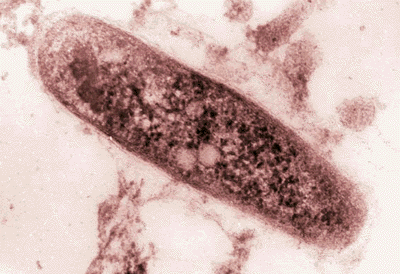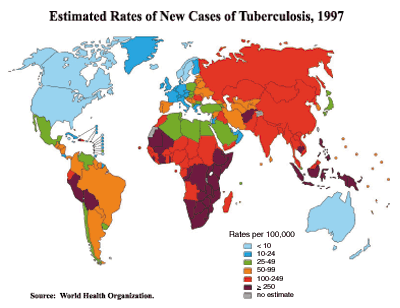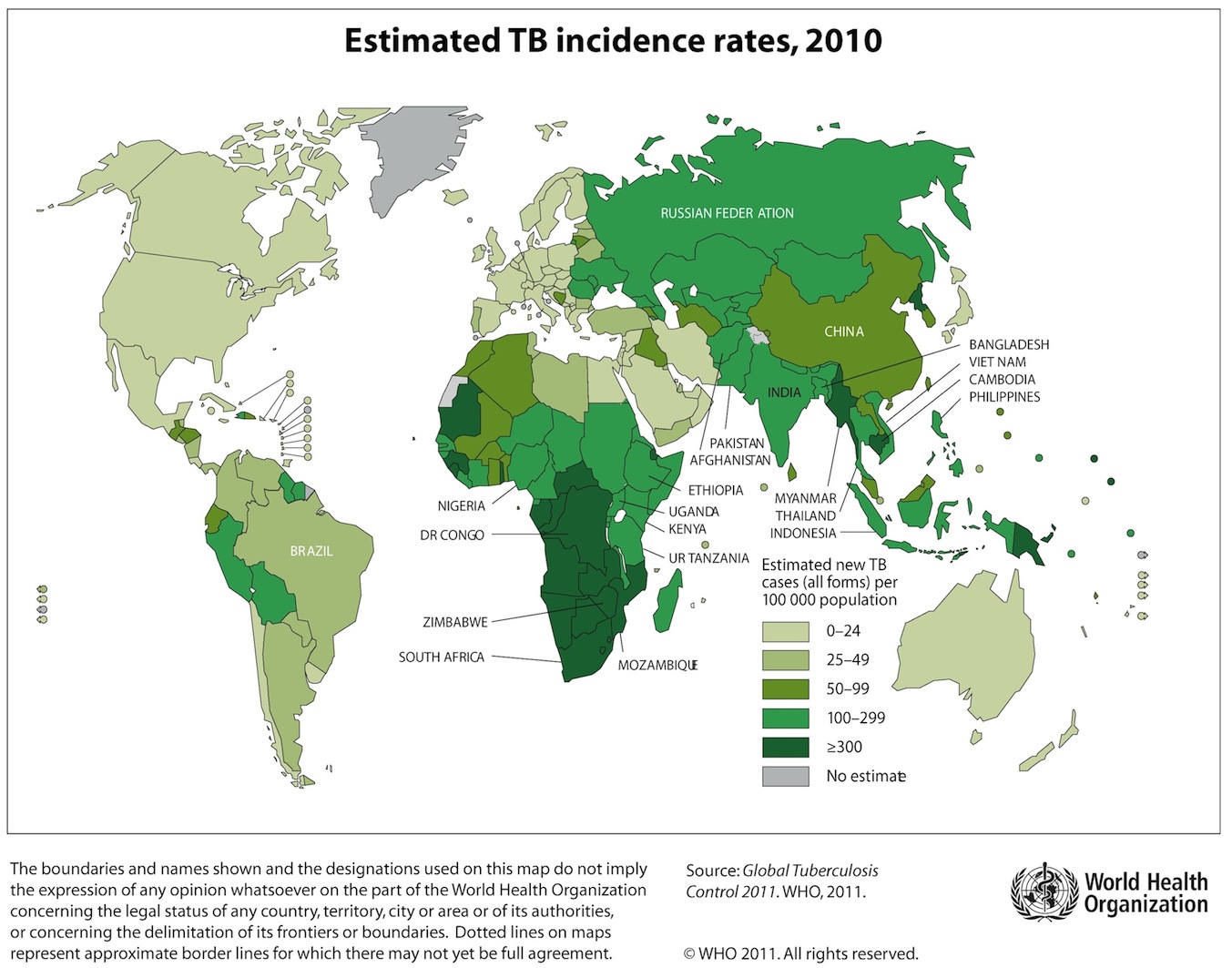 White Plague
White Plague 
TB, Tuberculosis in history is a tragically consequential detective story.
"The emaciated figure strikes one with terror...." [p. 118]
| Disease is both a source of & a motive for knowing what we do not know, and what we do with what we know. | |
 |
 |
| incidence of Tuberculosis in the world, 1997. | incidence of Tuberculosis in the world, 2010. |
What is known | Sample Essay | Themes | What is unknown | Rhetoric | discovery | summary | sources | next
1. Tuberculosis (TB) is a disease caused by bacteria called Mycobacterium tuberculosis. Mycobacterium tuberculosis, or tubercle bacilli, (pp. 107-110) mostly attacks the lungs, however it can also attack many parts of the body such as the kidney, the lymph nodes, brain and the spine.
2. Tuberculosis (TB) is the world's leading infectious killer of young and middle-aged adults, causing 26 percent of avoidable deaths in the developing world.
3. René and Jean Dubos, The White Plague, 1952.
How did knowledge of TB change based on the role of diagnostic practice, instrumentation and experimental research from one period to another?
- Diagnostic practice, instrumentation and theory
- Research versus testing
- communication from one physician to another.
- Two Sects: Reason and experience, theoreticians versus practitioners of medicine. Which was correct?
- "the significance of the term 'disease.' Etymologically speaking, the meaning seems simple and clear enough; the dis-eased person is one who is not at ease because of disturbing symptoms. And this definition provides the key to one of the most dangerous aspects of tuberculosis."
- …"diagnostic method not dependent upon subjective symptoms."
p. 119.
4. Nature and the bivariate role of character, circumstances, and customs in Tuberculosis that generated the White Plague.
sample
Essay
“The God in the Machine that devoured my Illusions ”
by
Joseph Siry"Ancient knowledge of disease was derived almost exclusively from the observation of symptoms."
White Plague, p. 70.
The story of understanding the causes, treatment and containment of maladies, morbidity, and disease in the past reveals several indecisive conceptual breaks in the development of science. These include an expression of tensions between descriptive versus experimental evidence, the unresolved antagonisms between the uses of diagnostic techniques and instruments for the prognosis of conditions versus patient histories, and the eventual social movement that revolutionized both the context of public health and quarantine after exposure, while emphasizing nutrition and exercise in the remedying of consumption and related sicknesses.
There is a split apparent between the contagionists and the hereditarians as to the ultimate sources of disease before the application of stethoscopes, autopsies, x-rays, and bacterial identification when diagnosing a sick person. Contagionists emphasized the environmental causes of exposure to all sorts of probable conditions that provoked the disease and sought remedies in fresh air and better dietary regimes. Whereas, the emphasis on hereditary causes of consumption provoked a heightened interest in eugenics and .
The slow development of biological science, in a cosmos of cause and effect was slow to catch up to findings in planetary science and especially chemistry:
- descriptive versus experimental evidence,
- techniques and tools for the diagnosis of conditions,
- the social context of public health, nutrition, and exposure.
The Road to where?
Last week's themes from Freud and Feynman revised in light of The White Plague:
Loss, death as the passageway from which there is no return
simplicity: does environment or contamination by exposure to sickness cause disease?
complexity: contagionists versus environmentalists may both be correct because the etiological agent of infection is an organism with its own specific ecological demands, genetics and nutritional behavior that exposes the limitedness of our descriptive techniques, our tools and our vocabulary for accurately describing health.
There is much difficulty in defining how rhetoric must be very precise when explaining concepts with multiple causes:
The rhetoric of the technological sublime or the fascination of Romanticism with death and decay, and the Enlightenment visions of a supplicant nature,
do or do not originate in the absence of the Renaissance in North America's brief past.
Europe had a Renaissance and was afflicted by tuberculosis, confused by its symptoms and treatments as surely was America; as nature's nation–without a Renaissance– the United States is peculiarly victimized by folly.
What is known | Sample Essay | Themes | What is unknown | Rhetoric | discovery | summary | sources | next
Nine propensities to consider for morbidity in history
A. Knowledge is a limited commodity: phthisis, diagnosis, prognosis
B. Symptoms: pertussis was confused with pulmonary tuberculosis, asymptomatic and recurrent strains.
C. Theory: four humors; phlegmatic
D. The nature versus nurture dispute between hereditarian and contagion assumptions as to the causal agents of the many maladies associated with the lungs, larynx, intestine, spine, skin, brain or kidneys.
E. The new means to decide, ... Percussion, 1761; vaccination, 1790s; Auscultation, 1816;sanatoria, 1854; & X-rays, 1890s.
F. The either, or approach failed. Knowing how technology works as opposed to realizing the quality of knowledge divergent tools allow us to verify can be severely restricted by the questions we are creative enough to ask.
Laënnec, Young, Williams, Brehmer, Trudeau, and Koch are all examples of original thinkers who were hard-working, yet creative enough to target the most robust problems in search of an explanation for what others misidentified, misunderstood and mistakenly informed the public.
1. Applied science or technology is the way we use what we know
2. The body of knowledge that we can know
3. The means we have (tools & technology)–"merely a mechanical toy"– (p. 89) and method used to reveal our errors.
What is known | Sample Essay | Themes | What is unknown | Rhetoric | discovery | summary | sources | next
What is the character of proof?
Those listed characteristics above are the three things Feynman argues are the characteristic traits of what McCloskey called a systematic description of material and physical, social and human, literate, & metaphorical understanding.
"The unitarian theory of phthisis was a brilliant concept based on precise observations of autopsy material; but Laënnec had never proved by experimentation that the different lesions of phthisis really did evolve one from the other in an orderly sequence, from the small tubercle, through the caseous ulcer, to the cavity stage."
p. 92.
"Laënnec could not prove his theory, because he did not know the primary cause of tuberculosis, moreover, could not produce the disease at will in experimental animals. He was limited to the observation of its final results in the patient."
pp. 92-93.
What is known | Sample Essay | Themes | What is unknown | Rhetoric | discovery | summary | sources | next
Dubos starts with an assertion that society sees what it is prepared to see given its biases, limited technology, and world view or weltanschauung derived theories that prevail.He commences where Freud & Marx left off in the labyrinth of interpreting technology and how well applied sciences reveal or hide significant knowledge of nature. The Dubos' team is on the same quest as Richard Feynman who was skeptical of the power to reason alone to create viable understanding of verifiable observations. Here the quest is to reveal the hidden meaning of our entanglements with nature, technology and fear, but in the realm of health and living conditions.
By nature we mean the characteristics of disease that for so long confused researchers that physicians with different technical means often inadvertently played into the social conventions (romanticizing disease with creative burst of genius) and fears. Theses fears took the form of controlling others (laws to stop the contagion) because of widespread social discontent over urban, industrial change or fostered the spread of mistaken orthodox religious assumptions that evil people manifested illness as a reflection of the Creator's wrath (hereditary bias). In the growing situation of cultural disintegration, social morbidity, and inequality of options neither nature (inheritance) nor nurture (the environment) were sufficient to provide an explanation for what, how, and to whom the disease symptoms of phthisis, consumption, and catarrh spread among all classes of the population.
Yellow Fever, malaria, pellagra, venereal disease, smallpox, cholera, bubonic plague, and melancholia were all --just to name some-- the help mates of tuberculosis in making modern society one in which death and sickness stalked all ages, but the young and aged especially leading to high mortality and morbidity rates.
Since the Renaissance threat of plague and disease steeped side by side with the twin illusions of providence and plenitude. Such a Manichaean perspective fed intense and fostered widespread delusions about the condition of nature and the character of humankind.In the quest for purpose, sanity and wisdom in the nineteenth century disease, democracy, descent, and social Darwinism combined to not only shatter cherished beliefs but to sustain illusions that Bacon in the sixteenth century –in calling these follies, idols– had hoped to eradicate with applied science.
Conditions of urban (pp. 197-203) as opposed to rural (p. 90) and commercial as opposed to industrial life fostered ecological ignorance of the actual biological conditions in which we live.
Currently our beliefs in progress and providence --then as now -- led people to blame the devil and sin for the existence of disease. Thus shame and sickness became so associated in the mind. So powerful is the association that today we still blame the victim of disease for their own unhealthy conditions. This is particularly true when there is an absence of informative clues as to a proper diagnosis.
These chest x-rays show advanced pulmonary tuberculosis. There are multiple light areas (opacities) of varying size that run together (coalesce). Arrows indicate the location of cavities within these light areas. The x-ray on the left clearly shows that the opacities are located in the upper area of the lungs toward the back..
Common problem in diagnosis before 1900 and X-rays were the confusion of symptoms with related, but different diseases.
What is known | Sample Essay | Themes | What is unknown | Rhetoric | discovery | summary | sources | next
Contact
Marshes of the Ocean Shore. Wetlands role in disease: malaria, yellow fever, ague.
The White Plague: Tuberculosis, Man, and Society. (1952)
Terms
Phthisis was a Greek name from PHTHOE for the symptoms of an individual shriveling up under exposure to extreme heat and was applied eventually after a Cappadocian monk in 200 BCE refereed to the consumption described in patient as phthisis
Pertussis is a highly communicable disease, commonly called whooping cough, occurring mostly in children and teenagers that is caused by Bordetella pertussis. Symptoms are initially those of nonspecific URI followed by paroxysmal or spasmodic coughing that usually ends in a prolonged, high-pitched, crowing inspiration.
Tuberculosis is an infectious disease that causes inflammation, the formation of tubercles and other growths within tissue, and can cause tissue death. The appearance is typical for chronic pulmonary tuberculosis but may also occur with chronic pulmonary histiocytosis and chronic pulmonary coccidioidomycosis. Pulmonary tuberculosis is making a comeback with new resistant strains that are difficult to treat. Pulmonary tuberculosis is the most common form of the disease, but other organs can be infected.
What is known | Sample Essay | Themes | What is unknown | Rhetoric | discovery | summary | sources | next
Date: 19 January 2008, & 29 February 2012, 13-Feb-2015



